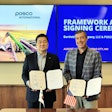
Understanding the impact of maximum residue levels (MRLs) can be complicated, but it’s important to keep grain flowing from the farm to international end-users.
The U.S. Grains Council (USGC) collaborated with the National Corn Growers Association and the international maize alliance to submit comments on the global economic impact of MRLs to the U.S. International Trade Commission in late 2019.
The groups are collectively concerned with a growing trend in which countries are moving away from international standards or reliance on science-based, risk-based approaches when setting MRLs for agricultural products, resulting in new barriers to trade.
The testimony outlines how crop protection products work as defense mechanisms for pest, disease and weather challenges, how they are regulated and how they have contributed to a more reliable food and fuel supply.
“Whether through the lens of the local farmer, export market development efforts or the macro trends of farming in the Americas, we hope to shed light on the impacts and considerations that high-volume, bulk commodities face when moving around the globe,” the groups wrote.
“We believe that crop protection products play a critical role in the global food production system and that missing or low maximum residue levels can have lasting and detrimental impacts on our ability to supply the world with its food and feed sustainably.”
MRL 101
An MRL is a regulatory standard that reflects both risk and hazard from exposure in a given environment, and then sets a scientific limit that reduces that risk well below any level that could be considered a health hazard. MRLs ensure food and feed products contain limited amounts of residue from crop protection products.
In the U.S, MRLs are set during the registration of a crop protection product and get a regular review. This number does not represent a food safety measure. Rather, MRLs serve to ensure that farmers are following safe label practices when using crop protection products.
Managing MRLs around the world is complex. Labels for crop protection products in the U.S. are based on the U.S. MRL. If the grain is being grown for export, that grain must meet both the MRL for the U.S. and that of the importing country — making export market MRLs crucial for market access.
When MRLs don’t match
When MRLs don’t match or are missing, trade disruptions can and do occur. For example, a missing MRL in a country that defaults to Codex would mean that any residue detection above 0.00 would trigger an MRL violation until Codex can set and approve an MRL — a process that can take years.
An MRL set to a different level than the exporting country creates serious headaches for global trade, particularly for bulk commodities. If an MRL does not align with either the U.S. MRL or international standards established by Codex, there is an increased risk for rejected shipments or additional testing.
These factors create obstacles to trade and farming production, particularly as the world continues to become more interconnected and MRL issues become more prevalent.
MRLs acting as non-tariff trade barriers
In some parts of the world, missing or diverging MRLs are starting to work as non-tariff trade barriers. Most alarming is the European Union’s (EU’s) changing preferences for a hazard-based approach to renewing authorization of existing crop protection products, rather than a risk-based approach.
The proposed EU hazard-based approach means an increasing number of active ingredients are losing their authorization, which would mean the reduction or removal of the MRLs of these long-used products. At near-term risk are commonly used products like glyphosate, malathion, propiconazole and lambda-cyhalothrin. These products, which are approved in producing countries like the U.S. but not in the EU, risk becoming subject to an MRL of 0.01 mg/kg default or even lower at any level of detection. These changes would cause serious issues for the grain trade.
In the case of the EU, U.S. farmers could lose access to products that have undergone rigorous testing, received U.S. approval and are recognized internationally as safe and legal. Nations could also ban or restrict the use of the same products in a ripple effect — ignoring international science-based, risk-based standards in favor of a desire to export to large markets like the EU. Both scenarios result in barriers to trade — and are of mounting concern the more prevalent MRL issues become. ■
Author: Allison Nepveux serves as the Manager of Trade Policy for the U.S. Grains Council, a non-profit organization that promotes the use of U.S. barley, corn, sorghum and related products worldwide. In this capacity, she develops and implements trade policy and biotechnology programs and assists overseas offices with market access initiatives.
READ MORE
Read the full testimony by clicking here.















